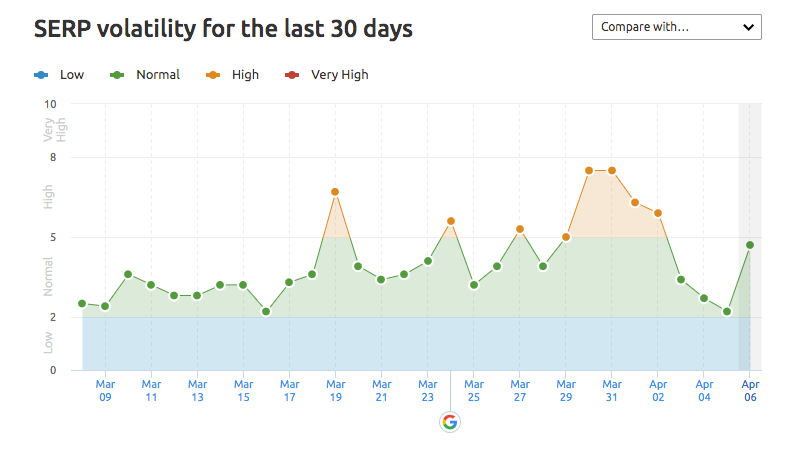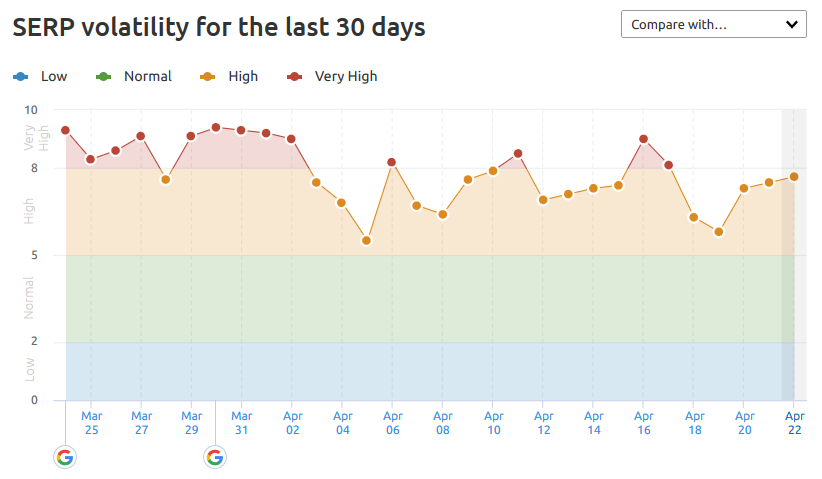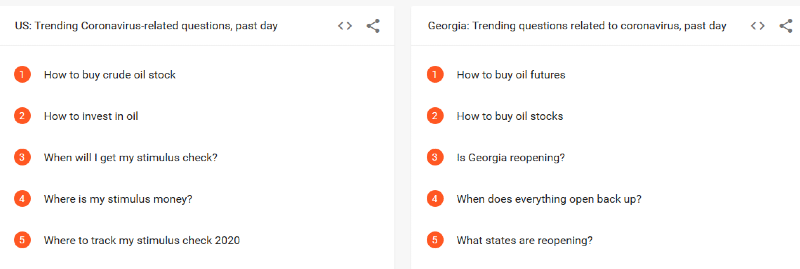Google Search Trends Amidst COVID-19 and How to Respond

We are in the midst of a massive shift in search behavior that’s impacting search results and traffic. Unlike a significant algorithm update though, no one saw this coming.
Now, as we figure out our new shelter-in-place lives, we’re also figuring out how to keep organic search traffic up.
In the past few weeks, the search results have been volatile.

SEMrush Sensor data for all categories, retrieved on April 6, 2020
This is especially true for things like news results (as we would expect right now):

SEMrush Sensor data for News category, retrieved on April 22, 2020
As we’re finding out, what you ranked for yesterday may no longer be the case. Path Interactive pointed out that the usual top-ranking sites for health queries are not on Page 1 anymore. At the same time, the CDC and WHO are claiming the top spots on Google.
As search behavior changes all over the world with new trends popping up daily, Google is striving to keep up with relevant results.
What is making the search results so volatile? In addition to a suspected algorithm update in late March, Google is dealing with an influx of new searches it has never seen before. Add to that the fact that people want different things as a result of the pandemic.
This different search behavior is no doubt giving AI systems a headache. The algorithm must think that the only thing important to people now are these new trending queries.
It must be difficult for the software to understand that we’re not always going to be in panic mode. The answers we want now will not be satisfied once things settle down. And I think that could be confusing. We’ll have to wait and see how the current crisis-driven behavior biases the top search results long-term.
As we know, search trends reflect the priorities of people. And as a business, it’s our job to listen and respond.
- What’s happening in search right now
- How to respond with SEO
- FAQ: How is the search behavior shift impacting online businesses?
What’s Happening in Search Right Now
There are many disruptive factors at play right now in the search results. As you may remember, RankBrain (Google’s search AI), is among the top three signals in Google’s algorithm.
What that means is that along with content and links, RankBrain helps determine rankings.
Google created RankBrain to handle the growing percentage of queries it had never seen before. You can imagine what RankBrain must be dealing with now. Each day, we’re seeing new searches that never existed before.

Google’s Coronavirus Search Trends data, retrieved on April 22, 2020
Not only are we seeing high-volume searches that never existed before (like “coronavirus money help”), but search behavior for goods and services is also changing.
It’s no surprise that searches for grocery stores are up while searches for restaurants are down. And new trends in searches for goods like cotton bandanas are up.
trends.embed.renderExploreWidget(“TIMESERIES”, {“comparisonItem”:[{“keyword”:”cotton bandanas”,”geo”:””,”time”:”2020-03-30T15 2020-04-06T15″}],”category”:0,”property”:””}, {“exploreQuery”:”q=cotton%20bandanas&date=now%207-d”,”guestPath”:”https://trends.google.com:443/trends/embed/”});
Now that people are sheltering in place, other trends include a drop in mobile searches and a rise in desktop.
WordStream reports a 24 percent drop on average in mobile search ad traffic. And Microsoft reports a rise in desktop searches compared to mobile.
Not to mention the amount of time now spent on social media like Facebook as people connect digitally, and how search is changing there, too.
All this is to say that the pandemic is shifting the way people search and behave online. Fortunately, the fundamentals of SEO have not changed. We would apply many of the same strategies today as we would in the past.
How to Respond with SEO
Here are four things to do now when it comes to SEO and keeping your website visible in the search results.
1. Understand Search and Ranking Trends
Look at Google Search Trends. You can use its coronavirus search trends hub to see what’s trending and refer to our guide to using Search Trends for more help.
You can use keyword tools like our free keyword suggestion tool or others like Ubersuggest to find different keywords you want to optimize for.
You can use our WordPress SEO plugin to get insights about the top-ranked sites for your keywords before you start writing content. This can give you key data points on what quality is for your targets.
Make sure you explore how search trends are impacting your particular niche. This Moz article has interesting ideas on the types of content to create per industry during COVID-19.
2. Continue to Publish Quality Content
Keep producing high-quality content. This is especially true for “Your Money or Your Life” sites, which would answer many search queries about the pandemic today. See our E-A-T guide for more info on this.
Now more than ever, Google needs help in finding and understanding the meaning of your content. So that means extra diligence with your optimization. See our up-to-date SEO checklist for ideas.
Google also recently gave tips on how health sites can optimize their content to be found in these times. Any website can apply these basics to help them get found.
3. Stay Relevant in Business and in Search Results
As people’s priorities change, so does search. Depending on how the economy reacts to the pandemic, search behavior may change for good.
For example, people may stop buying cars and want to sell them instead. New industries may emerge as a result of a potentially permanent work-from-home economy.
trends.embed.renderExploreWidget(“TIMESERIES”, {“comparisonItem”:[{“keyword”:”buy car”,”geo”:””,”time”:”2020-01-06 2020-04-06″}],”category”:0,”property”:””}, {“exploreQuery”:”date=today%203-m&q=buy%20car”,”guestPath”:”https://trends.google.com:443/trends/embed/”});
Search query data from Google Trends
Think about how you can be part of the conversation and add value now. What will that look like in the future, too?
Remember, if your webpages are not relevant to the searcher’s intent (what they want to accomplish), you will not be found online.
4. Be Patient But Act Now
SEO is already a game of patience. As Google works out the kinks in ranking the most relevant results, search results will be volatile, for some queries more than others.
But trends come and go, and as we pull out of this pandemic, searchers will turn their minds to other things.
There will be opportunities and challenges ahead. But SEO can support any shift in offers and messaging so that your business can be found for what people want.
Acting now will help your business weather the crisis, and come out ahead after it has passed.
For more on how to market and do SEO during COVID-19, see my earlier post Don’t Quarantine Your Marketing. If you’d like help navigating the online changes for your business, contact us right away.
FAQ: How is the search behavior shift impacting online businesses?
Search behavior has undergone a significant transformation. Understanding and responding to this shift is crucial for the survival and success of online businesses.
- The Rise of Conversational Search:
Search engines have become more sophisticated in understanding natural language, leading to the rise of conversational search. Users now ask questions in a way they might speak, using voice assistants and mobile devices. Online businesses should optimize their content for voice search by incorporating long-tail keywords and providing concise, informative answers.
- Mobile-First Indexing:
With mobile devices dominating internet usage, search engines have shifted to mobile-first indexing. This means that a website’s mobile version is the primary basis for ranking. Online businesses must ensure their websites are mobile-friendly, offering a seamless user experience across various devices.
- Local SEO and Geotargeting:
Search behavior has become increasingly localized, with users seeking information relevant to their immediate surroundings. Online businesses must invest in local SEO strategies, including accurate business listings and geotargeted content, to connect with nearby customers effectively.
- Visual and Video Search:
Visual and video searches are gaining prominence, driven by platforms like Pinterest and Google Lens. Online businesses should incorporate visual elements into their content and optimize images and videos for search engines.
- E-A-T and Content Quality:
Search engines now prioritize content quality and expertise, authority, and trustworthiness (E-A-T). Online businesses should focus on producing high-quality, authoritative content that demonstrates their expertise in their respective industries.
- AI and Machine Learning Algorithms:
Search engines employ AI and machine learning algorithms to understand user intent better. Online businesses can leverage these technologies to personalize content, recommendations, and advertisements for users, enhancing their overall experience.
- Featured Snippets and Structured Data:
Featured snippets have become a valuable source of organic traffic. Online businesses can increase their chances of being featured by structuring their content with schema markup and providing clear, concise answers to commonly asked questions.
- User Experience and Page Speed:
A fast-loading website and a positive user experience are crucial for search rankings. Online businesses must optimize their websites for speed, usability, and mobile responsiveness to retain visitors and improve search performance.
The shift in search behavior has far-reaching implications for online businesses. To thrive in this changing landscape, businesses must adapt their strategies by embracing conversational search, prioritizing mobile optimization, local SEO, visual content, and quality. Additionally, leveraging AI and machine learning, optimizing for featured snippets, and enhancing user experience is key to staying competitive.

3 Replies to “Google Search Trends Amidst COVID-19 and How to Respond”
Excellent advice. There is a lot of newer trends emerging on search due to this current pandemic. Regularly publishing quality posts, making use of good tools, and getting the proper data points is crucial for brands to dominate in SEO. Patience is always needed to see results, but we can work towards it from now.
That’s right, you need to constantly and persistently strive for good positions and do not stop positioning
LEAVE A REPLY









